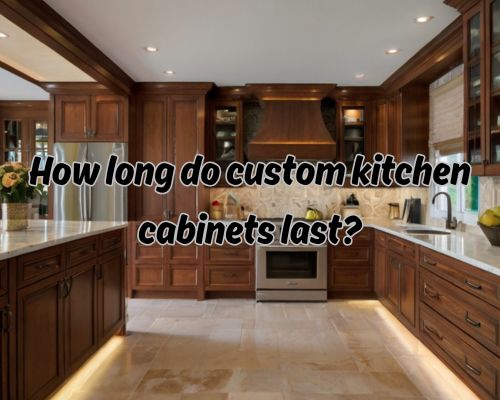
How Long Do Custom Kitchen Cabinets Last? Understanding Lifespan and Durability
How Long Do Custom Kitchen Cabinets Last? Understanding Lifespan and Durability
When investing in custom kitchen cabinets, it’s crucial to know how long they’ll serve you. The lifespan of your cabinets can greatly depend on factors such as the quality of materials used and the level of maintenance they receive.
With proper care, high-quality custom kitchen cabinets can last for at least 25 years.

These cabinets aren’t just about durability; they offer a blend of style and functionality tailored to your specific needs. Understanding the longevity of your cabinets allows you to appreciate the reliability and craftsmanship that go into creating bespoke designs suited to your kitchen space.
By choosing quality materials and ensuring regular maintenance, you can significantly extend the life of your kitchen cabinets.
Whether you are planning a kitchen remodel or purchasing cabinets for the first time, knowing what to expect in terms of durability will help you make an informed decision, see https://morningtoncabinetmakers.com.au/.
Factors Influencing the Longevity of Kitchen Cabinets
The lifespan of kitchen cabinets is influenced primarily by the materials used, the level of maintenance, and the surrounding environmental conditions. Each factor plays a critical role in determining how long your cabinets will endure without significant wear or damage.
Materials and Construction
The materials used in the construction of kitchen cabinets significantly affect their durability. Solid wood cabinets, such as oak or maple, offer superior longevity due to their hardiness and ability to withstand regular use.
Plywood cabinets provide a balance between affordability and durability, often outlasting many other engineered options. In contrast, MDF (medium-density fibreboard) and laminate cabinets are generally less durable, though they can be cost-effective choices for low-impact usage.
The construction techniques also contribute to cabinet longevity. Features like dovetail joints in the drawers enhance strength and resistance to wear over time.
Investing in high-quality materials and craftsmanship can ensure your cabinets last for several decades.
Maintenance and Care
Regular maintenance plays a vital role in extending the life of your kitchen cabinets.
Routine cleaning with gentle, non-abrasive cleaners prevents dirt build-up and surface damage, while using appropriate cleaning tools can avoid scratches.
Immediate attention to any water damage, especially in kitchens, is crucial as prolonged exposure can warp materials and cause swelling, particularly in MDF and laminate cabinets.
Cabinet refinishing can rejuvenate the appearance and protect the integrity of the wood. Reapplying finishes like varnish or paint not only improves aesthetics but also shields against moisture and everyday wear, visit https://morningtoncabinetmakers.com.au/ for more.
Environmental Influence
The environment in which your cabinets exist can impact their longevity.
Kitchens subject to high humidity levels or rapid temperature changes can cause materials to expand and contract, undermining cabinet integrity.
Controlling environmental conditions effectively with good ventilation and stable temperatures can mitigate these effects.
Direct sunlight exposure may lead to fading or discoloration, particularly in laminate and certain wood types. Strategically using blinds or curtains to protect cabinets from harsh sunlight can preserve their appearance and durability over time.
Maintaining optimal storage conditions will minimize environmental stressors that could otherwise reduce cabinet longevity.
When to Consider Cabinet Replacement or Refacing
Choosing between cabinet replacement or refacing involves evaluating the existing condition, potential benefits, size of renovations, and cost-effectiveness. Each approach has specific circumstances where it may be more suitable, depending on condition and fitting with your overall home improvement strategy.
Assessing Cabinet Condition
Understanding the current state of your cabinets is crucial in making an informed decision. Check for structural issues such as water damage or warping that might necessitate replacement rather than just refacing.
If your custom cabinets are high-quality and structurally sound but show wear in finishes or hardware, you might only need refacing. But if you have stock cabinets that are extensively damaged, replacement could be the better option.
Refacing Versus Replacement
Deciding between refacing and replacing involves weighing the benefits and costs.
Cabinet refacing is typically more cost-effective, often being 30% to 50% less expensive than a full replacement. It involves updating the exterior with new doors and veneer, leaving the structure intact.
Replacement is necessary when significant damage or a full redesign is needed. This option allows you to select new materials and styles, which can dramatically transform your kitchen. Consider replacement for outdated or low-quality stock cabinet structures.
Planning Your Home Improvement
When planning a kitchen renovation, factor in how changes align with your overall home improvement goals.
Refacing offers a quicker, less disruptive process. This is ideal if you’re looking to update aesthetics without a major renovation.
Consider the kitchen’s functionality. If layout changes are needed, replacement might be more suitable.
Set a budget that reflects potential costs and long-term value. Include possible hardware upgrades with refacing to enhance functionality.
For new designs or layouts, replacement provides a full refresh and possibly more resale value.
Each option should reflect your specific needs and long-term home improvement strategy. Make sure to balance cost, effort, and desired outcome.